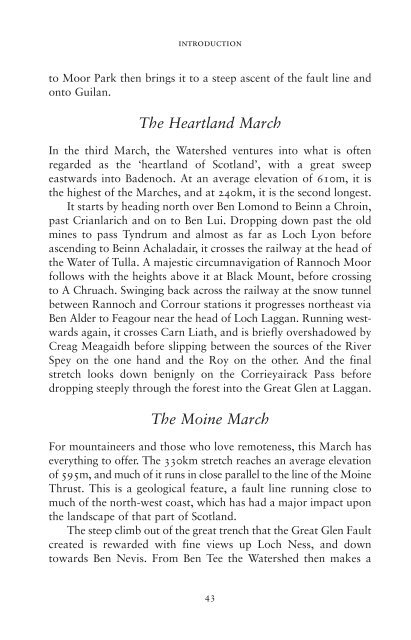Ribbon of Wilderness by Peter Wright sampler
If you’ve bagged the Munros, done the Caledonian Challenge and walked the West Highland Way, this is your next conquest. The Watershed of Scotland is a line that separates east from west; that divides those river basin areas which drain towards the North Sea from those which flow west into the Atlantic Ocean on the other. It’s a line that meanders from Peel Fell on the English border all the way to the top at Duncansby Head, near John O’ Groats – over 745 miles, through almost every kind of terrain. The Watershed follows the high ground, and offers wide vistas down major river valleys, towards towns and communities, into the heartlands of Scotland. Walk the Watershed in eight weeks Tackle short sections over a weekend 7 route maps Over 30 colour photographs Ribbon of Wildness provides a vivid introduction to this geographic and landscape feature, which has hitherto been largely unknown. The rock, bog, forest, moor and mountain are all testament to the Watershed’s richly varied natural state. The evolving kaleidoscope of changing vistas, wide panoramas, ever-present wildlife, and the vagaries of the weather, are delightfully described on this great journey of discovery.
If you’ve bagged the Munros, done the Caledonian Challenge and walked the West Highland Way, this is your next conquest.
The Watershed of Scotland is a line that separates east from west; that divides those river basin areas which drain towards the North Sea from those which flow west into the Atlantic Ocean on the other. It’s a line that meanders from Peel Fell on the English border all the way to the top at Duncansby Head, near John O’ Groats – over 745 miles, through almost every kind of terrain. The Watershed follows the high ground, and offers wide vistas down major river valleys, towards towns and communities, into the heartlands of Scotland.
Walk the Watershed in eight weeks
Tackle short sections over a weekend
7 route maps
Over 30 colour photographs
Ribbon of Wildness provides a vivid introduction to this geographic and landscape feature, which has hitherto been largely unknown. The rock, bog, forest, moor and mountain are all testament to the Watershed’s richly varied natural state. The evolving kaleidoscope of changing vistas, wide panoramas, ever-present wildlife, and the vagaries of the weather, are delightfully described on this great journey of discovery.
You also want an ePaper? Increase the reach of your titles
YUMPU automatically turns print PDFs into web optimized ePapers that Google loves.
<strong>Ribbon</strong>s <strong>of</strong> Wildness_2016_Layout 1 24/05/2016 19:26 Page 43<br />
introduction<br />
to Moor Park then brings it to a steep ascent <strong>of</strong> the fault line and<br />
onto Guilan.<br />
The Heartland March<br />
In the third March, the Watershed ventures into what is <strong>of</strong>ten<br />
regarded as the ‘heartland <strong>of</strong> Scotland’, with a great sweep<br />
eastwards into Badenoch. At an average elevation <strong>of</strong> 610m, it is<br />
the highest <strong>of</strong> the Marches, and at 240km, it is the second longest.<br />
It starts <strong>by</strong> heading north over Ben Lomond to Beinn a Chroin,<br />
past Crianlarich and on to Ben Lui. Dropping down past the old<br />
mines to pass Tyndrum and almost as far as Loch Lyon before<br />
ascending to Beinn Achaladair, it crosses the railway at the head <strong>of</strong><br />
the Water <strong>of</strong> Tulla. A majestic circumnavigation <strong>of</strong> Rannoch Moor<br />
follows with the heights above it at Black Mount, before crossing<br />
to A Chruach. Swinging back across the railway at the snow tunnel<br />
between Rannoch and Corrour stations it progresses northeast via<br />
Ben Alder to Feagour near the head <strong>of</strong> Loch Laggan. Running west -<br />
wards again, it crosses Carn Liath, and is briefly overshadowed <strong>by</strong><br />
Creag Meagaidh before slipping between the sources <strong>of</strong> the River<br />
Spey on the one hand and the Roy on the other. And the final<br />
stretch looks down benignly on the Corrieyairack Pass before<br />
dropping steeply through the forest into the Great Glen at Laggan.<br />
The Moine March<br />
For mountaineers and those who love remoteness, this March has<br />
everything to <strong>of</strong>fer. The 330km stretch reaches an average elevation<br />
<strong>of</strong> 595m, and much <strong>of</strong> it runs in close parallel to the line <strong>of</strong> the Moine<br />
Thrust. This is a geological feature, a fault line running close to<br />
much <strong>of</strong> the north-west coast, which has had a major impact upon<br />
the landscape <strong>of</strong> that part <strong>of</strong> Scotland.<br />
The steep climb out <strong>of</strong> the great trench that the Great Glen Fault<br />
created is rewarded with fine views up Loch Ness, and down<br />
towards Ben Nevis. From Ben Tee the Watershed then makes a<br />
43


















